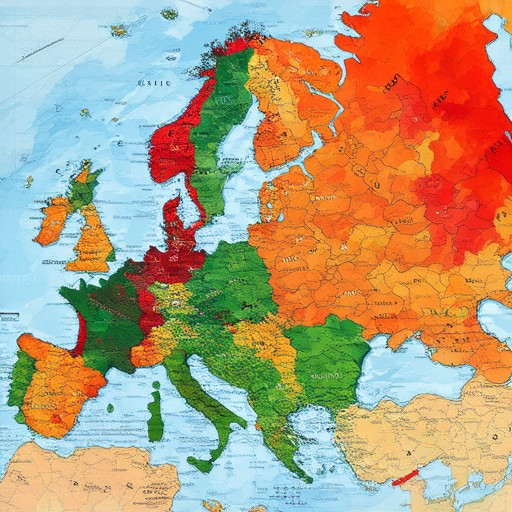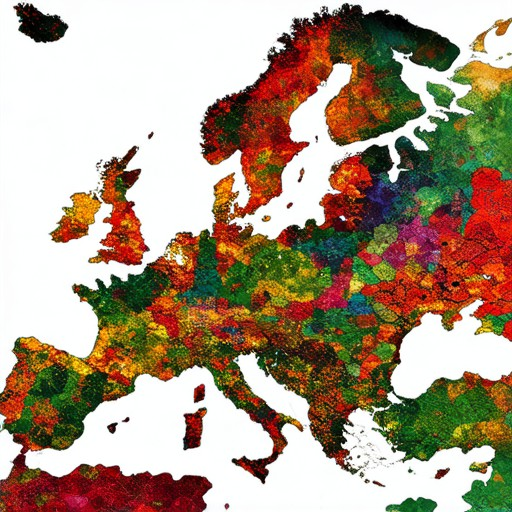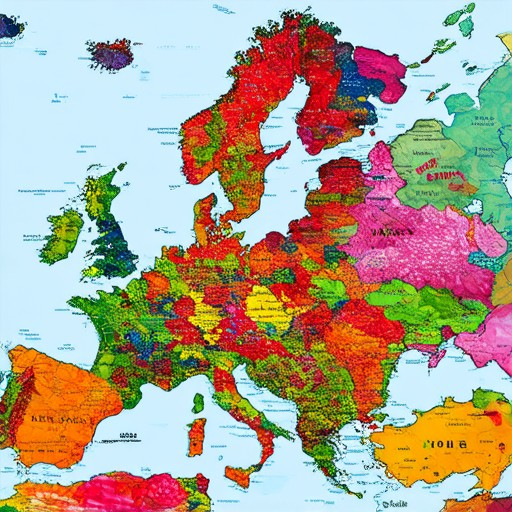Europe’s diverse landscapes and rich cultural heritage have given rise to some of the world’s most renowned wine regions. From the rolling hills of France’s Bordeaux to the sun-drenched vineyards of Italy’s Tuscany, Europe is brimming with areas celebrated for their exceptional winemaking traditions. Whether you’re a wine enthusiast planning a journey through Europe’s wine country or simply curious about the continent’s viticultural diversity, understanding the map of Europe’s wine regions offers a fascinating glimpse into its history, culture, and geography. This detailed guide will explore everything from the number of wine regions across Europe to the top producing countries, helping you uncover the secrets behind the continent’s most iconic wines.
Key Takeaways
– Top Wine-Producing Countries in Europe: Italy, France, Spain, Portugal, and Germany lead in wine production, offering diverse grape varieties and high-quality wines.
– Best Global Wine Regions: Napa Valley, Bordeaux, Tuscany, Willamette Valley, Barossa Valley, Maipo Valley, Piedmont, Sonoma County, Stellenbosch, and Yarra Valley are among the world’s premier areas, known for their exceptional winemaking.
– Highest Wine Consumption in Europe: Portugal tops the list, with an impressive 61.1 liters consumed per person annually, surpassing France, Italy, and Spain.

How Many Wine Regions Are There in Europe?
Europe is home to a diverse and extensive network of wine regions, each contributing unique terroirs and grape varieties. The exact count of wine regions can vary depending on the classification method used, but there are generally around 110 designated wine regions across the continent. These regions are known for their distinct climates, soils, and traditions, making European wines some of the most celebrated in the world.
What’s the Best Wine Region in Europe?
Europe is home to some of the most renowned wine regions globally, each offering unique terroirs, rich histories, and exceptional viticulture. Among these, several stand out as top contenders for wine lovers:
- Burgundy, France
Renowned for its Pinot Noir and Chardonnay wines, Burgundy’s reputation precedes itself. The region’s diverse soil types and climate conditions allow for an array of expressions, from delicate reds to robust whites. Villages like Beaune and Nuits-Saint-Georges are must-visits for wine enthusiasts. - Napa Valley, California (USA)
While technically not part of Europe, Napa Valley’s influence on global wine culture is undeniable. Its combination of sun-soaked hillsides and innovative winemaking techniques makes it a favorite among connoisseurs. Wineries like Opus One and Castello di Amorosa showcase the region’s potential. - Tuscany, Italy
Tuscany’s Chianti Classico and Brunello di Montalcino are iconic worldwide. The rolling hills and medieval villages, such as San Gimignano, provide a picturesque setting for wine exploration. The region’s diversity allows for both approachable reds and high-end luxury wines. - Barolo and Nebbiolo Regions, Piedmont, Italy
Piedmont’s Barolo and Nebbiolo grapes produce some of Italy’s most celebrated reds. The Langhe area, famous for its elegant and age-worthy wines, is a cornerstone of Italian viticulture. Vineyards like Gaja and Giacomo Conterno highlight the region’s expertise. - Rhône Valley, France
Known for its Syrah and Viognier wines, the Rhône Valley offers both bold, fruit-forward reds and crisp, aromatic whites. The region’s dramatic landscapes and historic villages, such as Vienne and Cornas, make it a fascinating destination. - Rioja, Spain
Rioja’s blend of Tempranillo, Garnacha, and Graciano grapes creates distinctive reds known for their balance and aging potential. The region’s mix of modern and traditional winemaking techniques ensures a wide range of styles, from classic Crianza to premium Gran Reservas.
Each of these regions offers something unique, whether you prefer the elegance of Burgundy, the power of Rioja, or the innovation of Napa Valley. Exploring these areas provides a deeper appreciation for Europe’s wine heritage and the artistry behind each bottle.

What is the Wine Capital of Europe?
The wine capital of Europe is Bordeaux, a city renowned for its rich wine history, extensive châteaux, and significant role in the global wine industry. Bordeaux is home to the world’s largest wine fair, Vinexpo, and is celebrated for its contributions to gastronomy and business tourism. The region’s hillsides are dotted with vineyards, making it a hub for wine production and innovation.
While Burgundy is also highly regarded for its premium wines and vineyards, Bordeaux is often highlighted as the primary wine capital due to its historical significance, commercial influence, and the concentration of winemaking resources within the city and surrounding area. Both regions play vital roles in shaping Europe’s wine culture, but Bordeaux’s综合影响力使其被广泛认为是欧洲的葡萄酒之都。
Bordeaux’s status as the wine capital is further reinforced by its hosting of major wine events and its position as a center for international congresses, making it a key destination for wine enthusiasts and professionals alike.

Top 5 Wine-Producing Countries in Europe
The European continent is renowned for its rich winemaking history and diverse grape varieties. Here are the top five countries contributing significantly to global wine production:
- Italy – Known for its vast array of wine regions, Italy leads in wine production with a mix of indigenous and international grape varieties. The country’s versatility in winemaking and commitment to quality make it a dominant force.
- France – A historical leader in wine production, France excels in quality and diversity. Its famous regions like Bordeaux, Burgundy, and Champagne contribute significantly to global wine exports.
- Spain – With an emphasis on high-quality wines and long aging potential, Spain produces a wide range of varietals such as Tempranillo and Garnacha.
- Portugal – Known for its unique Vinho Verde and Port wines, Portugal has emerged as a major player in international markets due to its innovative winemaking techniques.
- Germany – Renowned for its Riesling and Spätburgunder grapes, Germany’s precision winemaking and cool climate regions produce some of the world’s finest white wines.
These countries collectively account for a significant portion of global wine production, showcasing Europe’s expertise in viticulture and oenology.
For more details on these wine-producing regions and their unique contributions, visit our wine education hub .
What is the Best Wine Region in the World?
When exploring the world of wine, deciding which region produces the finest vintages can be overwhelming. Each continent offers unique terroirs, climates, and winemaking traditions. Here’s a curated list of the top wine regions globally, known for their exceptional quality and diversity:
- Napa Valley, USA
- Bordeaux, France
- Tuscany, Italy
- Willamette Valley, Oregon, USA
- Barossa Valley, Australia
- Maipo Valley, Chile
- Piedmont, Italy
- Sonoma County, California, USA
- Stellenbosch, South Africa
- Yarra Valley, Australia
Napa Valley reigns as one of the most renowned wine regions, famous for its Cabernet Sauvignon, Chardonnay, and Bordeaux blends. Its diverse microclimates and fertile soils make it a benchmark for premium winemaking.
Bordeaux, in southwestern France, is celebrated for its Merlot-based reds and elegant whites. Its classification system, including the prestigious “Cru” and “Grand Cru” designations, ensures high standards.
Tuscany’s Chianti, Brunello di Montalcino, and Super Tuscan wines are internationally acclaimed. The region’s rolling hills and Sangiovese grape variety contribute to its distinctive character.
Known for Pinot Noir and Chardonnay, Willamette Valley’s cool climate and diverse soils produce wines with intricate aromas and balanced acidity.
Barossa Valley is renowned for its Shiraz and Riesling wines. Its warm, spicy Shiraz has become a hallmark of Australian winemaking.
Maipo Valley excels in producing Carmenère and Malbec wines. Its unique combination of altitude and climate conditions creates distinctive profiles.
Piedmont’s Nebbiolo d’Alba and Barolo wines are celebrated for their elegance and complexity. The region’s mountainous terrain and calcareous soils enhance wine quality.
With its diverse appellations and varied climates, Sonoma County is a leader in Pinot Noir, Chardonnay, and Zinfandel production.
Stellenbosch is a hub for South African wine, known for its Cabernet Sauvignon and Bordeaux blends. Its proximity to the Atlantic Ocean influences the wine profile.
The Yarra Valley is noted for its sparkling wines and Chardonnay. Its cool climate and rich, volcanic soils contribute to its premium offerings.
Each of these regions brings something unique to the table, making every wine lover’s journey a fascinating exploration of terroir, grapes, and craftsmanship. Whether you prefer bold, fruit-forward wines or delicate, aromatic ones, there’s a region that will captivate your senses.

Which European Country Drinks the Most Wine?
As of recent data, several European countries stand out for their high wine consumption per capita. Leading the list is Portugal , with an impressive average of 61.1 litres consumed per person annually . This makes Portugal the top wine-drinking nation in Europe, significantly ahead of other major consumers like France , Italy , and Spain .
The high consumption rates in these countries can be attributed to a combination of favourable climatic conditions, rich viticultural heritage, and a strong cultural tradition of wine drinking. Each of these nations has a long history of winemaking, contributing to their high levels of wine consumption.
For instance, France is renowned for its extensive wine production and remains one of the top consumers globally. Meanwhile, Italy and Spain also boast significant per capita wine consumption, though they trail slightly behind Portugal.
If you’re interested in exploring the world of fine wines, consider visiting Fine Vines ‘ comprehensive guide to wine regions worldwide, where you can discover the unique characteristics of each country’s wine production and cultural significance.
Learn more about wine tasting techniques to enhance your appreciation for these exquisite beverages.



0 Comments